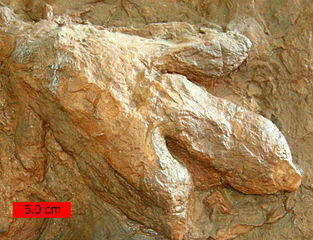How did dinosaurs leave fossils behind?

Dinosaur footprint fossil (Wikimedia Commons)

Dinosaur footprint fossil (Wikimedia Commons)
How does this align with my curriculum?
Using a toy dinosaur and some plaster of Paris, learn how dinosaur footprints could become fossils.
What You Need
- Bowl
- Spoon
- Model dinosaur (the foot of the dinosaur must fit inside the cup)
- Plaster of Paris
- Plastic cup
- Plastic wrap
- Plasticine
- Water
Safety First!
Do not ingest the Plaster of Paris.
What to Do
- Mould the plasticine into a flat disk 1/4 to 1/2 cm thick.
- Place the plasticine disk in the bottom of the cup.
- Tear a piece of plastic wrap and place it over the plasticine. Make sure the plastic wrap adheres to the plasticine.
- Make an impression (footprint) in the plasticine by pressing the foot of the dinosaur model down into the plasticine.
- Mix the plaster of Paris with water until it has a "pudding" consistency. Check the label of the box of plaster for instructions specific to the brand.
- Pour enough plaster of Paris mixture into the cup so that it forms a layer at least 3 cm thick on top of the plasticine. Make sure that the plaster doesn’t reach the top of the cup.
- Leave to dry overnight (or enough time for the plaster to dry). The cast mould should pop out easily when the plaster has hardened.
Discovery
When you walk through mud you leave footprints behind, much like dinosaurs did some 100 million years ago. If there are no disturbances to the mud, over time it will harden. After a long time, the mud will turn into sedimentary rock. Sedimentary rocks are made up of small bits of rock and sand that settle and eventually turn into rock. This is called an impression fossil (or mould fossil). Once the impression fossil has formed, more sediment may cover and encase it. These further layers of sediments may also harden and form what is called a cast fossil (the sediments take the shape of the impression fossil).
Paleontologists (scientists that study dinosaurs) are interested in both kinds of fossils. Fossils give paleontologists information about the height of the dinosaur and its gait. Gait is the way an animal moves. Scientists can determine the stride length of the dinosaur (how big its steps were), the speed at which it was moving, whether it walked on two or four legs, and whether it carried or dragged its tail.
- Using toothpicks and a chocolate chip cookie (or any cookie that has chunks in it), try to “dig out” and separate the chunks from the cookie. What was challenging about getting the chunks out of the cookie? How is this related to what paleontologists do?
For more information on this topic check out these Let's Talk Science resources:
- What is a dinosaur? (Lessons) - Students will use observing and sorting & classifying skills to learn that dinosaurs are extinct animals that share common characteristics.
- How big were dinosaurs? (Hands-on Activities) - Some dinosaurs were very big! Compare the sizes of different dinosaurs to the sizes of familiar objects you see in your community.
- Meat-eating Dinosaurs (Picture Collections) - 10 images of meat-eating dinosaurs
- Plant-eating Dinosaurs (Picture Collections) - 10 images of plant-eating dinosaurs.
What’s happening?
When you walk through mud you leave footprints behind, much like dinosaurs did some 100 million years ago. If there are no disturbances to the mud, over time it will harden. After a long time, the mud will turn into sedimentary rock. Sedimentary rocks are made up of small bits of rock and sand that settle and eventually turn into rock. This is called an impression fossil (or mould fossil). Once the impression fossil has formed, more sediment may cover and encase it. These further layers of sediments may also harden and form what is called a cast fossil (the sediments take the shape of the impression fossil).
Why does it matter?
Paleontologists (scientists that study dinosaurs) are interested in both kinds of fossils. Fossils give paleontologists information about the height of the dinosaur and its gait. Gait is the way an animal moves. Scientists can determine the stride length of the dinosaur (how big its steps were), the speed at which it was moving, whether it walked on two or four legs, and whether it carried or dragged its tail.
Investigate further
- Using toothpicks and a chocolate chip cookie (or any cookie that has chunks in it), try to “dig out” and separate the chunks from the cookie. What was challenging about getting the chunks out of the cookie? How is this related to what paleontologists do?
For more information on this topic check out these Let's Talk Science resources:
- What is a dinosaur? (Lessons) - Students will use observing and sorting & classifying skills to learn that dinosaurs are extinct animals that share common characteristics.
- How big were dinosaurs? (Hands-on Activities) - Some dinosaurs were very big! Compare the sizes of different dinosaurs to the sizes of familiar objects you see in your community.
- Meat-eating Dinosaurs (Picture Collections) - 10 images of meat-eating dinosaurs
- Plant-eating Dinosaurs (Picture Collections) - 10 images of plant-eating dinosaurs.